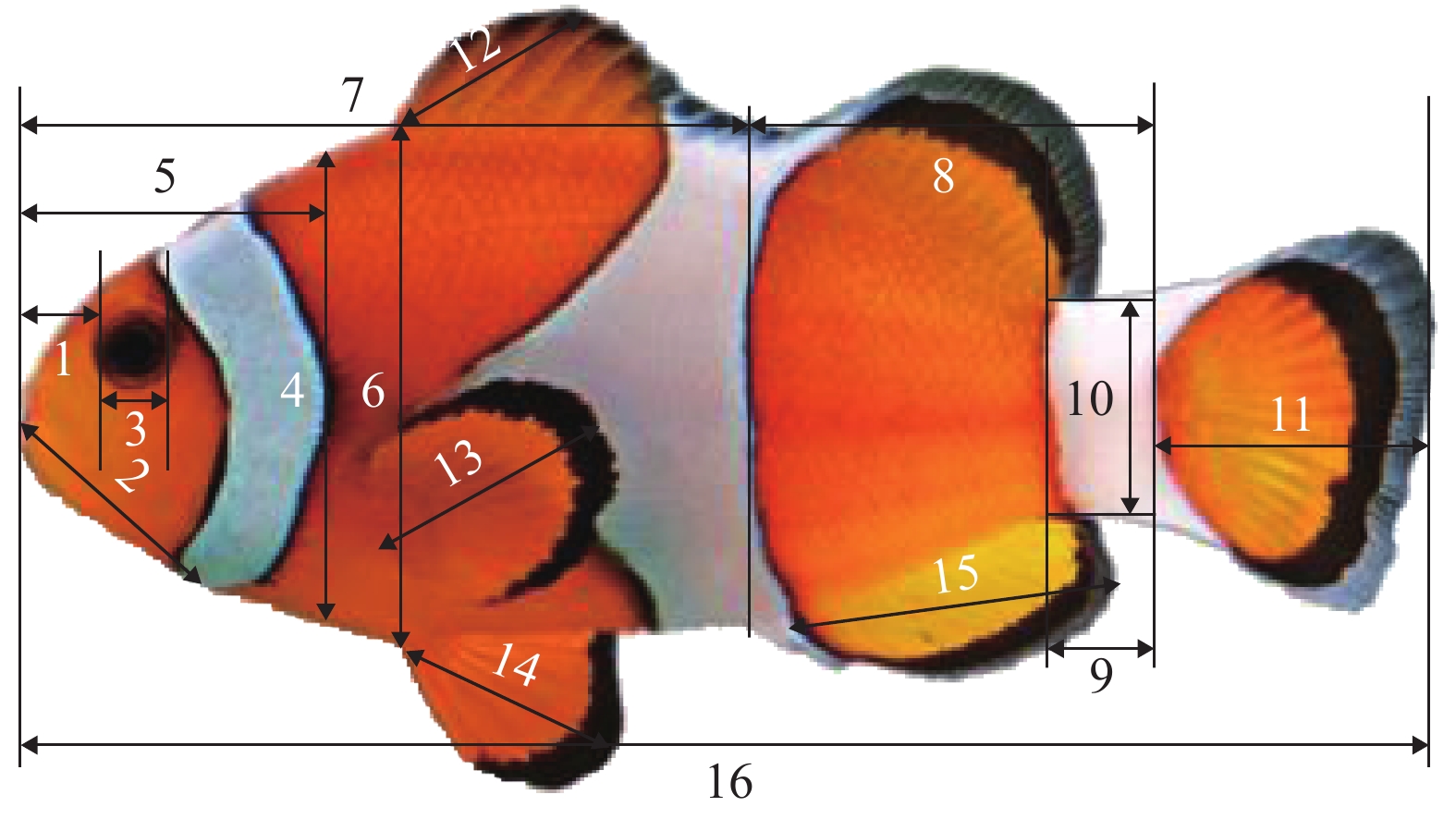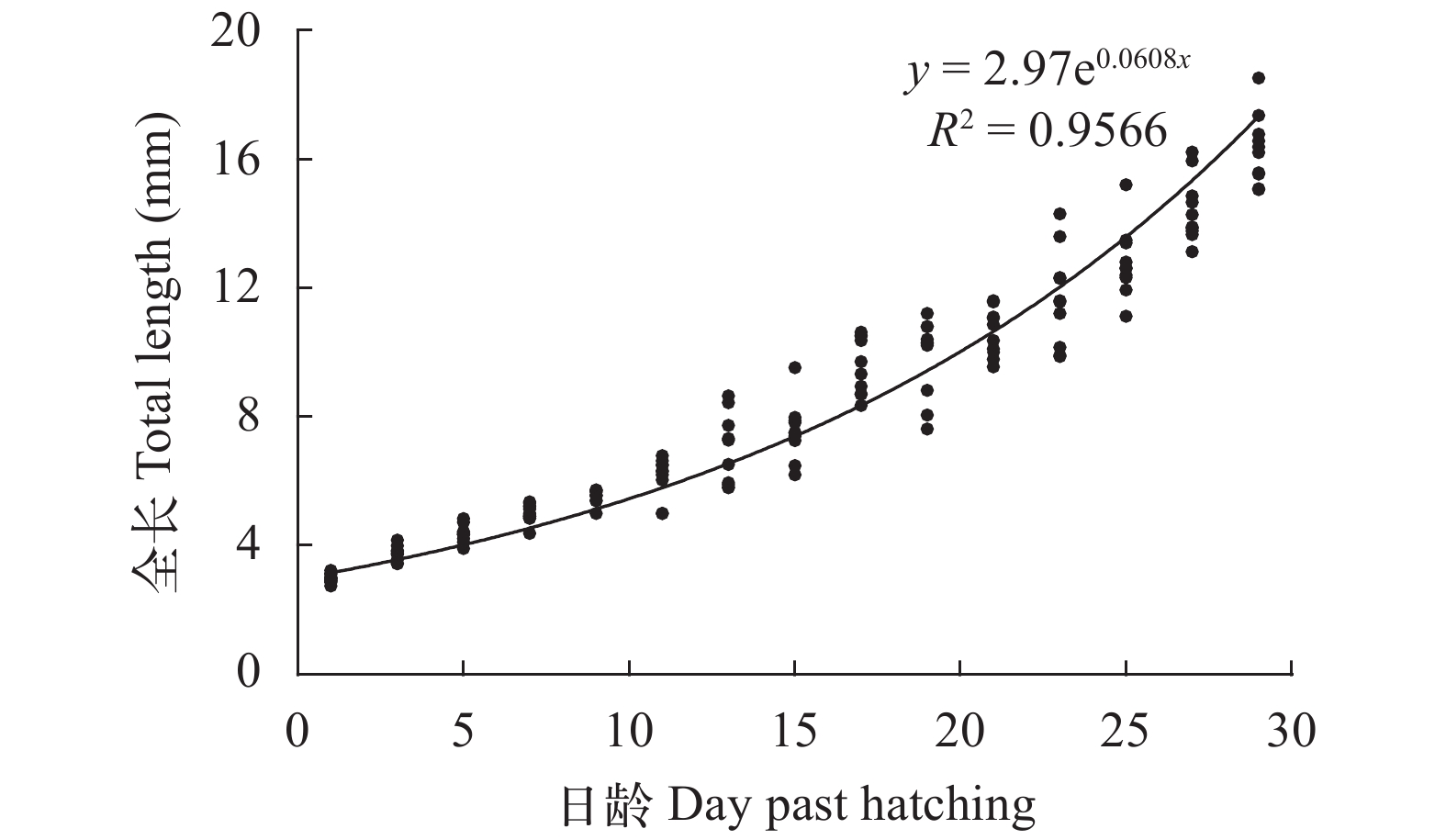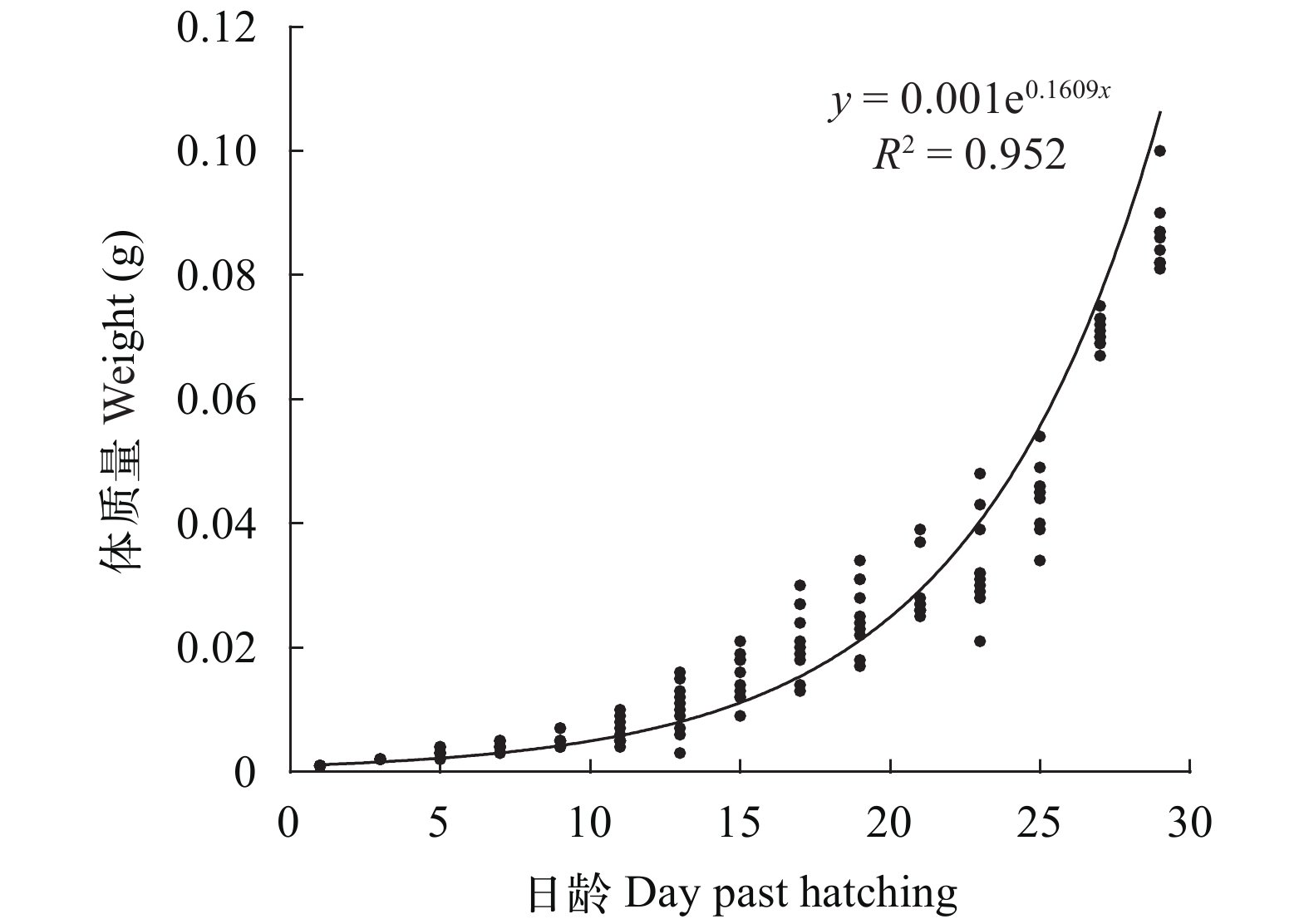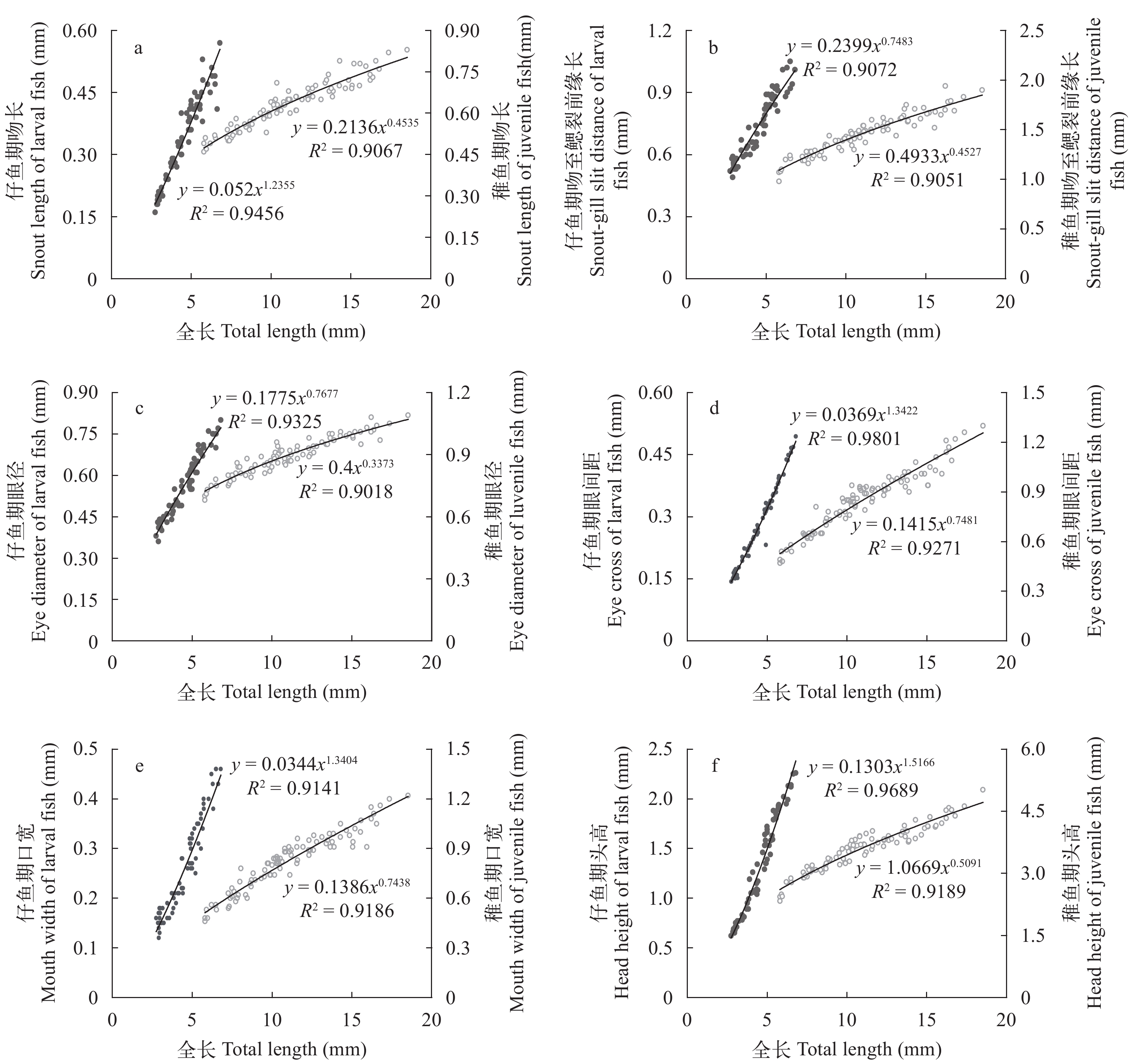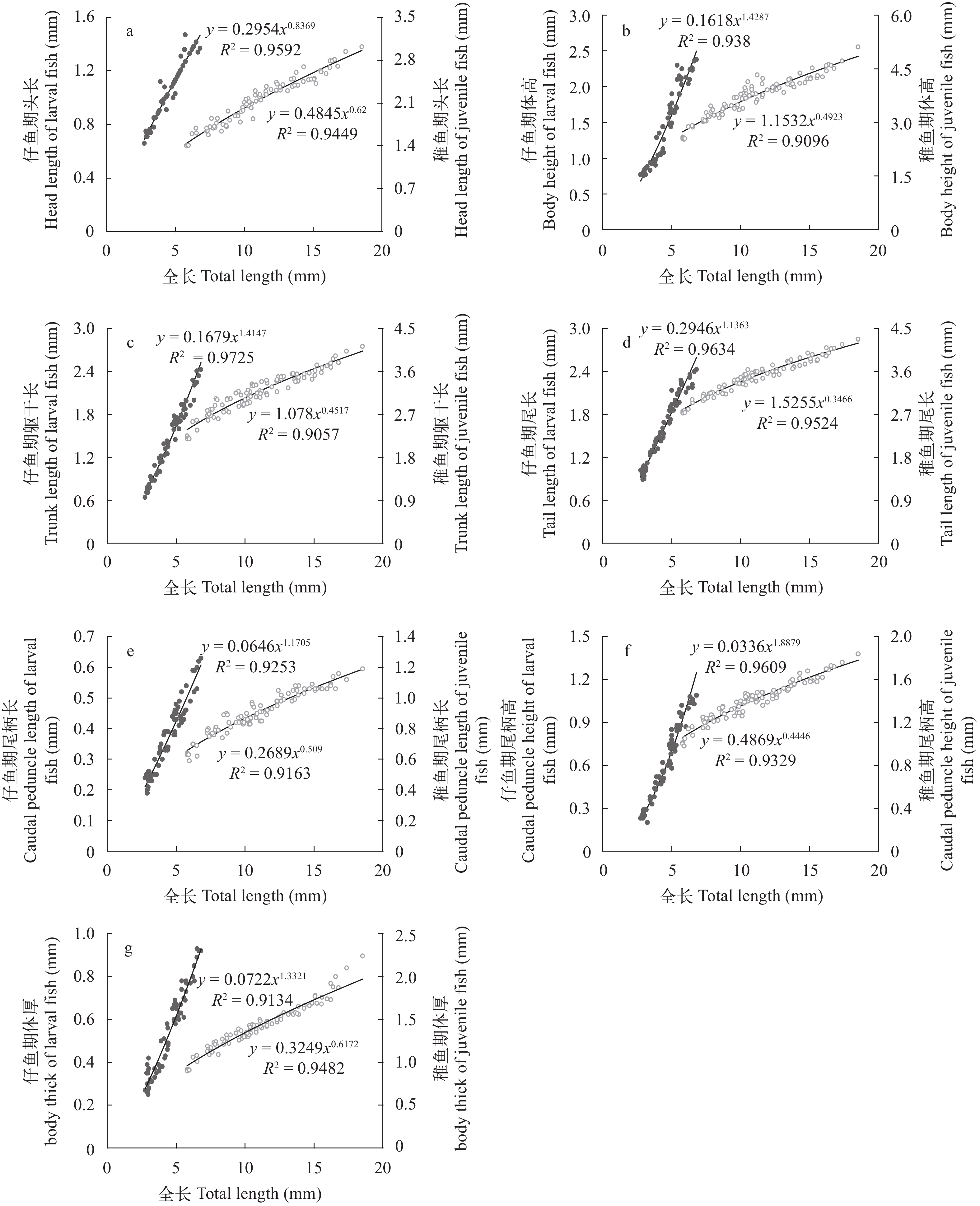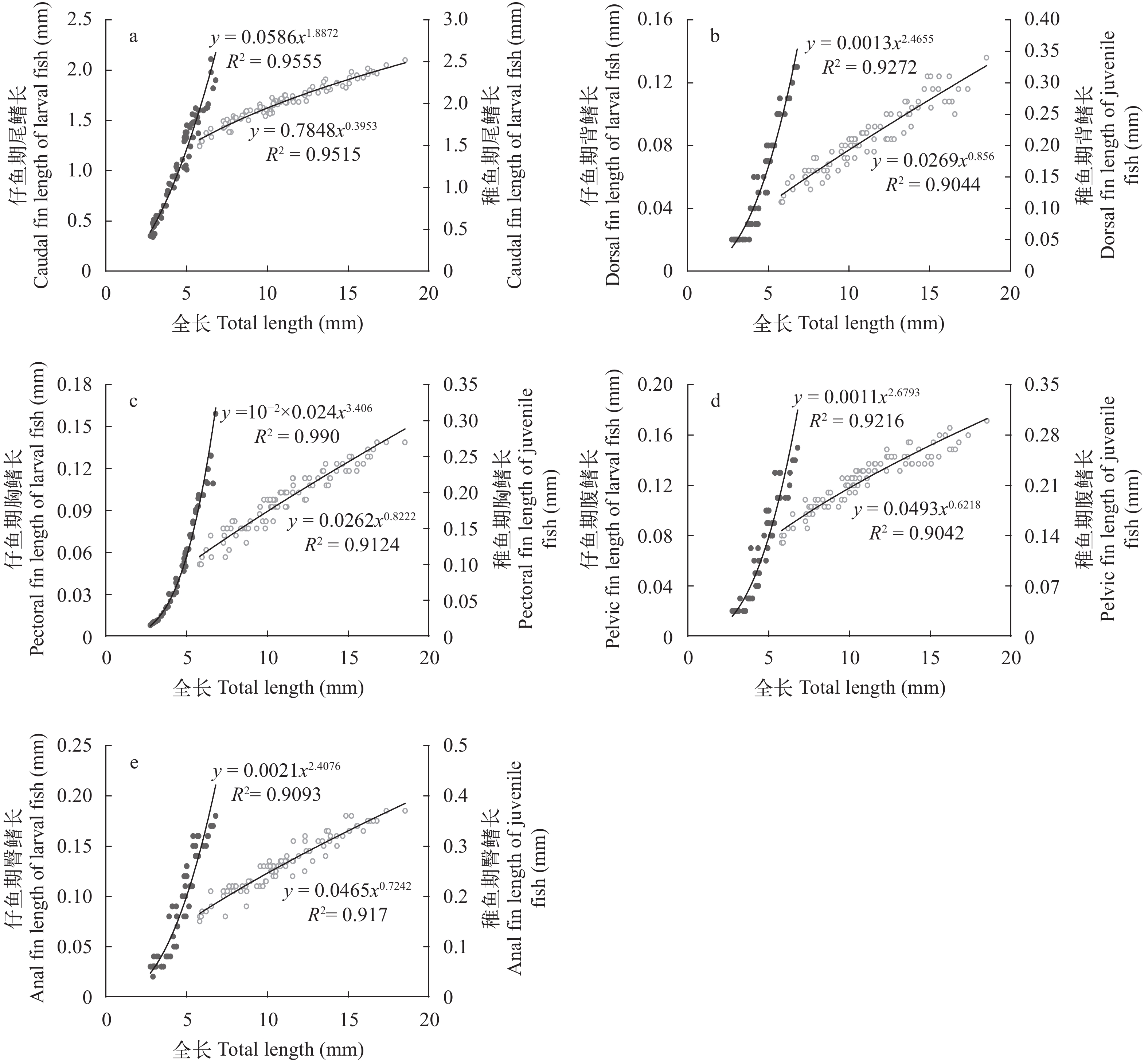ONTOGENETIC ALLOMETRY IN LARVAL AND JUVENILE CLOWN ANEMONEFISH AMPHIPRION OCELLARIS
-
摘要: 运用生态学和传统理论生物学的研究方法, 对孵化后眼斑双锯(Amphiprion ocellaris)仔、稚鱼在早期生存和环境适应上的异速生长及器官优先发育生态学意义进行了研究, 以期为眼斑双锯鱼人工繁殖和育苗提供参考资料。以11日龄为眼斑双锯鱼仔、稚鱼的区分时期, 结果表明, 眼斑双锯鱼仔、稚鱼的感觉、摄食和游泳等器官快速分化, 均存在异速生长现象。在头部器官中, 吻长、眼间距、口宽和头高在仔鱼期均为正异速生长, 吻至鳃裂前缘长和眼径为负异速生长。在身体各部位中, 仔鱼期体高、躯干长、尾长、尾柄长、尾柄高和体厚均为正异速生长, 仅头长为负异速生长; 在游泳器官中, 仔鱼期眼斑双锯鱼尾鳍、背鳍、胸鳍、腹鳍和臀鳍均为正异速生长。稚鱼期眼斑双锯鱼头部、躯干及游泳等各器官均为负异速生长。眼斑双锯鱼这些关键器官的异速发育, 对适应环境因子变化具有重要的生态学意义。Abstract: Ecological and traditional theoretical biology experiments were conducted to study the allometric growth of larval and juvenile clown anemonefish Amphiprion ocellaris at their early life stage, thus providing fundamental data in artificial propagation of clown anemone fish. The 11th day post hatch of fish was the junction between the larval and juvenile clown anemone fish. The results indicated that organs of feeling, feeding, and swimming developed and differentiated rapidly with allometric patterns during the larval and juvenile stage. As for head organs, snout length, eye cross, mouth width and head height exhibited positive allometric growth in larval stage, while the snout-gill slit distance and eye diameter exhibited negative allometric growth. As for torso region organs, body height, trunk length, tail length, caudal peduncle length, caudal peduncle height and body thick exhibited positive allometric growth in larval stage, and only head length exhibited negative allometric growth. As for swimming organs, caudal fin, dorsal fin, pectoral fin, pelvic fin and anal fin all exhibited positive allometric growth. In juvenile stage, the head, torso and swimming organs of the clown anemone fish were all negative allometric growth. The allometric development of the key organs of clown anemone fish has important ecological significance for adapting to changes in environmental factors.
-
在水域生态系统中, 种内和种间关系本质上表现为营养关系, 这种关系使水生生物构成了一个相互依存并相互制约的有机整体, 从而实现物质和能量的循环和流动[1, 2]。栖息于水域生态系统中各个物种间的营养关系并不是简单的食物链关系, 而是由各种食物链彼此交错形成的一种网状关系, 即水生食物网[1—5]。水域生态系统正是通过食物网进行着物质和能量的流动, 从而维持自身的动态平衡状态[1]。传统的食物网测定方法是肠含物分析法, 因具有工作量大、鉴别困难的缺点[6], 限制其在水生生物营养结构方面的应用, 相反稳定同位素法(Stable isotope analysis, SIA)能快速准确地评估生态系统长期的营养结构[7—10]。目前, SIA已广泛运用于池塘、河流、湖泊、海洋和湿地等水域的食物网测定。如叶学瑶等[11]通过测定阳澄湖鱼类稳定同位素值提出应当关注δ13C—δ15N双坐标图中的边缘鱼类如翘嘴鲌(Culter alburnus)、达氏鲌(Culter dabryi)的变化; 赵冬福等[12]比较增殖区与非增殖区的食物网推断放养鲢鳙会改变群落食物网结构; 李学梅等[13]研究了长湖拆围后鱼类群落营养结构的变化特征, 为该湖渔业资源修复提供依据; 霍堂斌等[14]通过对黑龙江中游主要鱼类食物网的构建得出了该生态系统营养结构图; 温周瑞等[15]研究发现浮游植物和附着藻类为贡湖流域内鱼类的主要碳源; 而国外常用δ13C、δ15N和δ18O来区分野生与养殖品种[16], 同时结合食物网分析重金属(Hg等)在食物网中的生物富集作用[17]。
浑太河流经人口稠密, 工农业发达的东北老工业基地[18—20], 近几十年来, 采砂、农田耕作、城镇化、水利工程和酷渔滥捕等人类活动已经引起流域内水生生物栖息地日渐恶化[21—23]、水生生物资源不断减少[24—26]、物种濒危程度不断加剧及生物多样性日益降低等一系列问题, 河流健康状况不佳及生态服务功能的减弱严重制约了流域内社会经济绿色高质量发展[19, 23, 24]。因此, 深入了解该生态系统的结构和功能, 颁布详细的保护政策迫在眉睫。目前, 关于浑太河流域生态系统的研究主要集中在鱼类群落结构[18—20]、水质状况[23—25]和底栖生物多样性[26, 27]等方面, 而通过SIA测定群落营养结构的相关研究还未见报道。本文针对浑太河流域面临的水生态环境恶化与渔业资源衰退等问题, 利用碳、氮稳定同位素技术分析流域内水生生物的稳定同位素值并以此建立营养级图谱, 揭示该流域水生生物营养结构, 进而构建浑太河流域食物网, 为浑太河开展生态修复和保护工作提供参考。
1. 材料与方法
1.1 研究区域概况
浑太河(122°05′—125°17′E, 40°40′—42°10′N)位于我国东三省之一的辽宁, 是我国辽河流域的重要分支, 主要由浑河与太子河组成, 流域面积达27300 km2, 全长近900 km[28], 流经辽宁省一些重要的农业、工业及城市区域[29]。为调查浑太河流域水生生物食物网结构, 分别于2020年秋季(10月)和2021年春季(5月)对浑太河流域的8个站位开展2次渔业资源调查工作(图 1)。
1.2 样品采集与处理
采用刺网、电捕及地笼对鱼类样品进行采集, 现场对新鲜的样本进行种类鉴定, 并测量体长和体重, 样本测量完后转入冰柜中速冻, 运回实验室取其背部白肌。鱼类鉴别及食性判断等主要参考《东北地区淡水鱼类》[20]。植物类样本在现场采集后使用蒸馏水清洗干净后, 60℃烘干、研磨。浮游生物使用WhatmanGF/F滤膜抽滤后, 用1 mol/L盐酸酸化后, 60℃烘干、研磨。所有样本的采集和前处理方式均参照徐军等[30]。
1.3 稳定同位素分析
所有样品的同位素比值均采用稳定同位素比率质谱仪(Isoprime 100, 英国)测定, 每测定12个样品后加测1个标准样, 保证数据的准确性。碳、氮稳定同位素标准物质为咖啡因(Caffeine, IAEA-600)与大气氮, 测定结果以δ13C、δ15N表示, 其公式为:
$$ \delta{X}(\text{‰})\text=\left({{R}}_{\text{sample}}-{{R}}_{\text{Standard}}\right)/{{R}}_{\text{Standard}}\text{×1000} $$ 式中,
$\delta{X}$ 为所测样品的δ13C或δ15N,$ {{R}}_{\text{sample}} $ 为样本的同位素比值(13C/12C或15N/14N),$ {{R}}_{\text{Standard}} $ 为参考标准物质的同位素比值。营养级(Trophic level, TL)计算公式为:
$$ \text{TL} = \left({{\delta}^{\text{15}}\text{N}}_{\text{consumer}}-{{\delta}^{\text{15}}\text{N}}_{\text{baseline}}\right)/{\delta}^{\text{15}}\text{N}+\lambda $$ 式中,
${{\delta}^{\text{15}}\text{N}}_{\text{consumer}}$ 为待测样品氮同位素值,${{\delta}^{\text{15}}\text{N}}_{\text{baseline}}$ 为基准生物的氮同位素值,${\delta}^{\text{15}}\text{N}$ 为相邻营养级的氮富集度, 本研究取3.4‰[31]。λ为基准生物的营养级, 选取初级消费者浮游动物为基准(Baseline), λ=2。1.4 数据分析
使用Excel 2019进行碳、氮稳定同位素值基础统计。使用SPSS 26进行单因素方差分析(ANOVA)检验比较渔获物δ13C、δ15N值及营养结构的时空差异。通过ArcGIS 10.2、Origin 2021软件制作站点分布图及营养级图谱。分别利用基于R 4.2.1的SIBER和MixSIAR包对整个浑太河流域渔获物的δ13C和δ15N值进行分析, 计算氮同位素比值范围(δ15N range, NR)、碳同位素比值范围(δ13C range, CR)、生态位总面积(Total area, TA)、平均离心距离(Mean distance to centroid, CD)、最邻近距离平均值(Mean nearest neighbor distance, NND)和最邻近距离标准差(Standard deviation of nearest neighbor distance, SDNND)六个群落营养结构指标[32]与基础碳源对渔获物的贡献率。
2. 结果
2.1 稳定同位素δ13C、δ15N值特征
本实验两个季度共采集渔获物4276尾, 隶属于3目6科20属23种, 其中共测定同位素样品343个(表 1)。秋季主要渔获物的δ13C值为–37.18‰[黑鳍鳈(Sarcocheilichthys nigripinnis)]— –19.28‰[兴凯银(Squalidus chankaensis)], 差值达17.90‰, δ15N值为7.98‰[中华绒螯蟹(Eriocheir sinensis)]—14.15‰(黑鳍鳈), 相差6.04‰; 春季主要渔获物的δ13C值为–27.40‰[方氏鳑鲏(Rhodeus fangi)]— –20.53‰[银(Squalidus argentatus)], 相差6.87‰, δ15N值为8.72‰[抚顺(Gobio fushunensis)]—16.51‰[小黄䱂(Micropercops swinhonis)], 相差7.79‰。比较不同食性渔获物的δ13C和δ15N值发现, 肉食性[δ13C=(–24.08±3.31)‰, δ15N=(12.83±2.69)‰]的δ13C值与植食性[δ13C=(–23.89±2.84)‰, δ15N=(11.95±1.89)‰]和杂食性[δ13C=(–24.37±3.22)‰, δ15N=(11.77±2.12)‰]相比无显著差异(P>0.05), 但肉食性的δ15N值显著高于杂食性(P<0.05)。
表 1 浑太河生态系统碳、氮稳定同位素值Table 1. δ13C and δ15N values in the Hun-Tai River ecosystem (n=343, x±SD)种类Species 食性
Feeding habit秋季Autumn 春季Spring 样本量n δ13C (‰) δ15N (‰) 样本量n δ13C (‰) δ15N (‰) 䱗Hemiculter leucisculus Om 8 –24.33±0.85 12.94±0.71 10 –26.52±2.17 12.74±1.28 彩副鱊Paracheilognathus imberbis Om 5 –26.04±1.01 12.10±0.85 — — — 方氏鳑鲏Rhodeus fangi Om — — — 8 –27.40±2.59 11.76±2.52 高体鳑鲏Rhodeus lighti Om 13 –26.18±4.67 11.75±2.34 10 –25.65±2.06 12.22±1.37 大鳍鱊Acheilognathus macropterus Om 16 –28.44±6.20 12.87±3.13 13 –25.04±1.57 12.37±1.58 麦穗鱼Pseudorasbora parva Om 12 –26.67±9.36 12.67±1.28 13 –23.27±1.97 13.06±1.1 黑鳍鳈Sarcocheilichthys nigripinnis Om 3 –37.18±10.76 14.15±0.62 — — — 银Squalidus argentatus Om — — — 5 –20.53±0.54 10.87±0.47 亮银Squalidus nitens Om — — — 3 –24.52±0.29 11.48±0.37 清徐胡Huigobio chinssuensis Om 18 –22.16±4.12 11.82±1.75 7 –25.95±1.24 13.42±2.54 棒花鱼Abbottina rivularis Om — — — 7 –24.26±1.22 13.77±1.83 鲫Carassius auratus Om 36 –26.03±6.99 11.71±1.58 9 –25.11±1.82 11.06±1.84 北方须鳅Barbatula barbatula nuda Om 10 –23.95±0.53 9.00±1.02 9 –25.29±3.99 10.16±1.36 泥鳅Misgurnus anguillicaudatus Om 7 –26.85±8.77 8.11±1.95 3 –24.27±1.25 9.80±1.65 日本沼虾Macrobrachium nipponense Om 7 –22.62±1.63 12.03±1.89 6 –24.61±1.73 12.29±2.77 中华绒螯蟹Eriocheir sinensis Om 5 –25.52±0.41 7.98±2.02 — — — 宽鳍鱲Zacco platypus He 22 –23.66±2.48 12.18±1.76 19 –24.21±3.24 10.55±2.39 鲢Hypophthalmichthys molitrix He 4 –30.10±7.01 10.57±1.22 — — — 拉氏鱥Rhynchocypris lagowskii Ca 17 –22.67±3.18 10.59±3.65 18 –22.89±3.24 10.55±2.39 抚顺Gobio fushunensis Ca — — — 3 –25.95±0.73 8.72±0.74 兴凯银Squalidus chankaensis Ca 5 –19.28±0.27 11.96±0.16 — — — 小黄䱂Micropercops swinhonis Ca 6 –34.66±10.89 13.02±0.97 3 –25.55±0.24 16.51±1.49 纹缟虾虎鱼Tridentiger trigonocephalus Ca — — — 3 –26.06±0.43 14.64±0.71 浮游植物Phytoplankton 8 –26.75±1.89 4.12±0.76 8 –25.49±1.55 2.34±0.83 浮游动物Zooplankton 8 –26.38±1.80 5.19±1.71 8 –26.12±2.52 9.25±0.73 颗粒有机物Particulate organic matter 8 –26.28±1.76 4.97±2.45 8 –26.52±1.55 2.97±0.62 陆生植物Terrestrial plant 9 –30.57±4.56 7.06±2.86 4 –28.37±0.95 4.45±1.39 水生植物Aquatic plant 15 –25.55±3.63 6.90±1.61 18 –29.33±2.27 5.02±2.30 着生藻类Periphytic algae 5 –21.89±3.33 1.65±0.84 6 –24.09±3.09 5.18±1.43 注: Om、He和Ca 分别表示杂食性, 植食性和肉食性; “—”表示无相关数据Note: Om, He and Ca indicate omnivore, herbivore and carnivore, respectively. “—” indicates no data 除此之外, 选取同种类不同季节和同种类不同支流的渔获物δ13C、δ15N值进行时空差异比较。结果表明, 在整个浑太河流域, 春季时渔获物δ13C、δ15N值相较于秋季小幅度上升(图 2a; P>0.05); 而太子河渔获物的δ13C值显著高于浑河(图 2b; P<0.01), 但δ15N值无显著差异(P>0.05)。
![]() 图 2 浑太河流域同种渔获物δ13C和δ15N值的时空差异a为浑太河同种渔获物不同季节的δ13C和δ15N值; b为浑太河同种渔获物不同支流的δ13C和δ15N值; **表示差异极显著(P<0.01)Figure 2. The spatiotemporal differences of δ13C and δ15N values of the same selected species in the Hun-Tai Rivera. δ13C and δ15N values of the same selected species in different seasons in the Hun-Tai River; b. δ13C and δ15N values of the same selected species in different tributaries in the Hun-Tai River; **indicates highly significant difference (P<0.01)
图 2 浑太河流域同种渔获物δ13C和δ15N值的时空差异a为浑太河同种渔获物不同季节的δ13C和δ15N值; b为浑太河同种渔获物不同支流的δ13C和δ15N值; **表示差异极显著(P<0.01)Figure 2. The spatiotemporal differences of δ13C and δ15N values of the same selected species in the Hun-Tai Rivera. δ13C and δ15N values of the same selected species in different seasons in the Hun-Tai River; b. δ13C and δ15N values of the same selected species in different tributaries in the Hun-Tai River; **indicates highly significant difference (P<0.01)2.2 营养级
通过δ15N值计算营养级(图 3), 浑太河流域秋季主要渔获物营养级为2.57(中华绒螯蟹)—4.39(黑鳍鳈), 均值为3.64±0.69, 跨度为1.82, 属于3个营养级; 春季营养级为1.71(抚顺)—4.00(小黄䱂), 均值为2.64±0.66, 跨度为2.29, 属于4个营养级, 秋季营养级跨度小于春季。不同食性渔获物营养级之间差异较大, 杂食性的营养级为2.03—4.03, 植食性的营养级为2.49—3.81, 肉食性的营养级为1.71—4.05。
选取同种类不同季节和同种类不同支流的渔获物营养级进行时空差异比较。由图 4可见, 秋季浑太河渔获物的营养级显著高于春季(秋季: 3.65±0.70; 春季: 2.64±0.66; P<0.01), 其中宽鳍鱲(Zacco platypus)、䱗(Hemiculter leucisculus)、大鳍鱊(Acheilognathus macropterus)、鲫(Carassius auratus)、拉氏鱥(Rhynchocypris lagowskii)和日本沼虾(Macrobrachium nipponense)的营养级降幅均大于1(图 3), 而降幅最小的为小黄䱂和泥鳅(Misgurnus anguillicaudatus); 不同支流的营养级差异也极显著(图 4; 浑河: 3.38±0.61; 太子河: 3.77±0.83; P<0.01), 特别是棒花鱼(Abbottina rivularis)、方氏鳑鲏、高体鳑鲏(Rhodeus lighti)、小黄䱂、麦穗鱼(Pseudorasbora parva)。
2.3 群落营养结构
根据稳定同位素值计算生物群落指标, 在浑河流域(图 5a), 秋季的CR值(基础食物源)、TA值(生态位空间)、CD值(营养多样性)、NND值(营养位置)均高于春季, 只有NR值(食物网长度)、SDNND值(营养冗余程度)略低于春季。而在太子河流域(图 5b), 秋季的CR值、TA值、CD值、NND值、SDNND值明显高于春季, 但NR值较低。在整个浑太河流域(图 5c), CR、TA、CD、NND、SDNND值随时间呈递减趋势, 只有NR值有所上升。对比两个支流的各项指标(图 5d), 太子河的六项群落营养结构指标值均大于浑河。
![]() 图 5 浑太河流域生物群落指标a, b, c分别为浑河、太子河、浑太河不同季节鱼类生物群落指标; d为浑太河不同支流鱼类生物群落指标Figure 5. The community-wide metrics in the Hun-Tai Rivera, b and c represent the community-wide metrics in different seasons in the Hun, Taizi and Hun-Tai River respectively; d represents the community-wide metrics in different tributaries in the Hun-Tai River
图 5 浑太河流域生物群落指标a, b, c分别为浑河、太子河、浑太河不同季节鱼类生物群落指标; d为浑太河不同支流鱼类生物群落指标Figure 5. The community-wide metrics in the Hun-Tai Rivera, b and c represent the community-wide metrics in different seasons in the Hun, Taizi and Hun-Tai River respectively; d represents the community-wide metrics in different tributaries in the Hun-Tai River2.4 潜在碳源贡献率
本研究调查到的水生植物有蒌蒿(Artemisia selengensis)、水烛(Typha angustifolia)、荻(Miscanthus sacchariflorus)、芦苇(Phragmites australis)、水蓼(Polygonum hydropiper)、香蒲(Typha orientalis)、虉草(Phalaris arundinacea)、具芒碎米莎草(Cyperus microiria)和穗状狐尾藻(Myriophyllum spicatum); 陆生植物有披碱草(Elymus dahuricus)、旱柳(Salix matsudana)、春榆(Ulmus davidiana var. japonica)、汉白杨(Populus ningshanica)和酸模(Rumex acetosa)。
不同季节浑太河流域5种潜在碳源[浮游植物、陆生植物、颗粒有机物(POM)、水生植物、着生藻类]对不同鱼类食源的贡献率如表 2所示。秋季时各潜在碳源贡献率顺序为水生植物(36.15%)>陆生植物(24.24%)>着生藻类(17.10%)>浮游植物(13.21%)>POM(9.30%), 而春季时为陆生植物(27.09%)>着生藻类(22.70%)>水生植物(18.66%)>浮游植物(18.51%)>POM(13.04%), 其中水生植物两季的贡献率波动最大。在两条支流中, 浑河潜在碳源贡献率顺序为陆生植物(36.60%)>着生藻类(22.36%)>浮游植物(17.92%)>POM(12.92%)>水生植物(10.20%), 而太子河的顺序为POM(29.01%)>陆生植物(26.52%)>着生藻类(23.91%)>水生植物(10.83%)>浮游植物(9.73%), 其中陆生植物和POM的贡献率在空间分布上存在较大波动。
表 2 浑太河流域不同季度鱼类基础食物碳源贡献率[均值(5%—97.5%置信区间)]Table 2. The contribution rate of basic food carbon sources of fish in the Hun-Tai River in different seasons (mean proportion with 5% and 97.5% confidence intervals)种类
Species秋季Autumn (%) 春季Spring (%) 浮游植物
Phytoplankton陆生植物
Terrestrial plantPOM 水生植物
Aquatic plant着生藻类
Periphytic algae浮游植物
Phytoplankton陆生植物
Terrestrial plantPOM 水生植物
Aquatic plant着生藻类
Periphytic algae䱗Hemiculter leucisculus 15.4
(0.3—66.5)29.3
(5.1—72)11.9
(1—59.1)26.6
(3.1—78.4)16.7
(1.1—66.4)16.3
(0.5—66.8)41.5
(10.1—85.1)11.5
(0.4—55.3)17.1
(0.3—67.9)13.6
(0.6—52.8)彩副鱊Paracheilognathus imberbis 16.5
(0.4—64.6)24.7
(3.5—66.2)12.3
(1.3—55.7)29.9
(3.4—79.9)16.6
(0.9—71.4)方氏鳑鲏Rhodeus fangi 17
(0.5—69.2)42.6
(9.7—88.3)12.5
(0.3—57.4)18.4
(0.3—72)9.6
(0.5—37.8)高体鳑鲏Rhodeus lighti 8.4
(0.2—52.8)13.2
(0.6—57.6)5.3
(0.3—35.2)61.9
(12.4—96.7)11.1
(0.3—57.2)18
(0.4—71.5)32.2
(8.1—78.5)13.2
(0.3—59.4)18.4
(0.3—72.4)18.2
(1.1—51.8)大鳍鱊Acheilognathus macropterus 12.9
(0.4—67)41.7
(8.6—86)9
(0.5—49.7)21.7
(1.8—78)14.6
(0.8—62.6)17.7
(0.4—69.1)31.6
(7.8—70.9)14
(0.4—56.6)17.6
(0.3—67.8)19.1
(1.4—56.1)麦穗鱼Pseudorasbora parva 11.7
(0.4—58.7)25.2
(3—72.2)6.6
(0.4—39.9)40.7
(4.3—90.2)15.8
(0.7—69.9)15.6
(0.3—65.4)25.4
(6.3—63.4)10.6
(0.4—45.2)16.4
(0.3—66.7)32
(2.5—71.4)黑鳍鳈Sarcocheilichthys nigripinnis 4.9
(0.1—34.4)2.8
(0.1—14.6)2.4
(0.1—14.6)82.9
(47.2—98.9)7
(0.2—44.7)银Squalidus argentatus 19.1
(0.6—71.4)12.1
(2.1—40.7)13.1
(0.3—57.9)18.3
(0.3—72.6)37.4
(3.2—86.1)亮银Squalidus nitens 19.5
(0.8—72.1)25.5
(4.3—71.4)15.3
(0.5—67.3)19.9
(0.3—74.2)19.8
(1—61.5)清徐胡Huigobio chinssuensis 14.3
(0.5—69.7)23.2
(2.9—65.8)9.8
(0.8—57.2)33.5
(3.5—86.2)19.1
(1.1—73.3)16.3
(0.3—63.7)44.7
(11.8—85)11.8
(0.3—57.8)16.6
(0.3—65.8)10.6
(0.5—37.8)棒花鱼Abbottina rivularis 16.8
(0.4—63.3)34.9
(10.1—77.6)11.3
(0.3—48.6)16.2
(0.3—64.5)20.8
(1.1—59.7)鲫Carassius auratus 14.8
(0.5—66.1)19.7
(2.6—59.6)8.7
(0.9—45.5)39.7
(6.7—85.9)17.1
(0.9—74.7)20.6
(0.5—76)22.8
(3.9—64)15.4
(0.4—67.4)21.4
(0.3—74.1)19.8
(1.4—65.9)北方须鳅Carassius auratus 17
(1—49.9)14.1
(3.1—42.5)12.5
(3.1—35)36.2
(12.1—74.3)20.1
(2.4—64.6)18
(0.7—51.5)23.7
(11.6—55.1)12.6
(0.9—39.5)18.9
(0.7—53.1)26.8
(2.5—64.9)泥鳅Misgurnus anguillicaudatus 24.2
(0.5—77)7.5
(0.6—32.1)22.3
(1.3—70.1)23.1
(2.1—73)23
(0.9—86.2)22.4
(0.6—82.3)17.7
(2.3—60.5)16.7
(0.3—73.4)19.7
(0.3—74.6)23.5
(1.1—73)宽鳍鱲Zacco platypus 12.1
(0.4—50.2)27.4
(4.2—70.4)9.5
(0.7—52.4)33.3
(5—84.1)17.7
(1—74.2)15.6
(0.4—61.2)17.6
(4.1—50.8)10.8
(0.5—46.5)18.3
(0.3—77.2)37.6
(3.1—77.8)鲢Hypophthalmichthys molitrix 18.7
(0.5—71.5)15.9
(1.1—56.8)13.3
(1.1—54.6)35.1
(3.3—85.3)17
(0.8—74.9)拉氏鱥Rhynchocypris lagowskii 12.1
(0.4—59.4)20.5
(2.4—63.4)9.5
(0.9—53.1)37.7
(4.4—86.4)20.3
(1—75.1)20.2
(0.4—80.2)11.2
(1.9—41)11.3
(0.4—47)18.9
(0.3—73.5)38.4
(2.6—83.9)抚顺Gobio fushunensis 21.8
(0.5—80)20.6
(1.6—72.1)18.1
(0.3—84.9)22.5
(0.3—81.1)17
(0.6—71.6)兴凯银Squalidus chankaensis 9.6
(0.4—59.4)14.3
(0.8—58.1)6.7
(0.5—39)52.6
(5.5—94.9)16.7
(0.6—70)小黄䱂Micropercops swinhonis 14.3
(0.4—67.5)28.3
(2.9—79.2)9.6
(0.7—53.7)32
(2.7—89.4)15.7
(0.9—69.1)14.8
(0.4—62.1)50.8
(16.6—87.5)10.1
(0.3—47.9)14.5
(0.3—63.2)9.8
(0.5—36.3)纹缟虾虎鱼Tridentiger trigonocephalus 16.7
(0.5—66.5)44.7
(11.1—86.5)11.1
(0.3—50.9)16.5
(0.3—68.9)11.1
(0.5—40.8)3. 讨论
3.1 稳定同位素δ13C、δ15N值特征
浑太河流域(表 1)的δ13C值为–37.18‰— –19.28‰, 相差17.9‰; δ15N值为7.98‰—16.51‰, 相差8.53‰, 与黑龙江中游[14](δ13C: –32.00‰— –17.32‰; δ15N: 7.58‰—14.78‰)、长江中游[33](δ13C: –33.83‰— –17.36‰; δ15N: 4.83‰—15.13‰)、大宁河[34](δ13C: –29.74‰— –16.61‰; δ15N: 4.54‰—17.51‰)、香溪河[35](δ13C: –28.30‰— –13.90‰; δ15N: 4.80‰—14.40‰)等江河水域相似, 渔获物稳定同位素比值(δ13C和δ15N)范围较广, 远高于阳澄湖[11](δ13C: –28.98‰— –20.65‰, δ15N: 11.92‰—17.85‰)、长湖[13](δ13C: –27.70‰— –24.80‰, δ15N: 11.40‰—16.60‰)、贡湖[15](δ13C: –23.10‰— –28.10‰, δ15N: 14.50‰—19.10‰)等湖泊的稳定同位素比值范围, 这可能由于江河相比于湖泊流域面积大, 水体流动性强, 基础外源性食物源输入较多(δ13C值范围大)[14, 33], 其鱼类营养级位置较为分散(δ15N值范围大), 食物竞争压力较小。另外稳定同位素比值与海拔和经纬度相关[36], 浑太河流域海拔差在1500 m左右[28], 远高于上述湖泊。
生物组织的δ13C值可以确认食物来源, 而δ15N值可以计算营养级[37]。本研究肉食性、植食性和杂食性鱼类三者的δ13C值无显著差异(表 1; P>0.05), 据此推测三者的食物来源较接近。而植食性鱼类的δ13C值略高于其余两种鱼类, 与着生藻类的δ13C值较高有一定联系[11]。肉食性鱼类的δ15N值最高, 也符合其处在群落中较高的营养位置。植食性和杂食性鱼类δ15N值无差异(P>0.05)可能由于本流域中水生植物占了杂食性鱼类基础食源的很大部分[11]。不同季节浑太河流域同种类渔获物的δ13C值与δ15N值变化不显著(图 2a; P>0.05), 但随时间有所上升, 可能由于浑太河春季日照时间长, 风力大等气候条件[28], 导致渔获物减少低δ13C、δ15N值水生植物的摄食比例, 增加高δ13C、δ15N值着生藻类的摄食比例。浑河同种类渔获物的δ13C、δ15N值均小于太子河(图 2b), 且δ13C值差异极显著(P<0.01), 除浑河流域面积较小外[28], 还可能由于浑河流域内农业用地较多[38], 而太子河流域周围以林地为主[39], 外源性碳源较为丰富。
3.2 营养级
浑太河秋季主要渔获物营养级范围跨度小于春季(图 3), 主要原因可能为秋季没有采集到抚顺等低营养级消费者, 春季没有黑鳍鳈等高营养级消费者所导致的物种组成差异所致。浑太河流域的营养级为1.71—4.39(图 3), 黑龙江中游[14]的营养级为1.06—3.98, 跨度均超过了2.5个营养级, 而太湖[15](3.30—4.40)与阳澄湖[11](2.05—3.80)营养级范围较小。同时比较浑太河与其他水域相同鱼类的营养级发现, 浑太河鱼类营养级偏高[9, 11, 13, 15], 推测这些现象是由于δ15N基准物的选择不同[40], 本研究选取的基准物为浮游动物, 而其余湖泊选取了底栖无脊椎动物蚌类和螺类[9, 11, 13, 15], 二者的δ15N值均存在一定的种内、种间差异[40]。为了减少由种类组成造成浮游动物δ15N值差异, 本研究使用浮游生物网在采样站点100 m范围内进行3—5次收集并混合, 并将非浮游动物物质分离。同时大型河流与湖泊的营养程度不同, 而栖息环境的营养状态会影响食物组成及营养级[40, 41], 且本研究采集的渔获物体型偏小, 不同规格鱼类具有显著的稳定同位素差异[7, 41], 这些因素都可能造成营养级差异。河流生态系统中水生生物营养级的高低也与其渔业资源开发情况有关[11], 本研究中低营养级渔获物占比偏多(图 3), 由此可知浑太河流域水生生物被过度开发。
秋季的营养级远高于春季(图 4; P<0.01), 推测与春季浮游植物生物量高(未发表数据)有关, 消费者以初级生产者浮游植物为主要饵料导致营养级降低[11]。同时营养级范围波动大表明其食物来源广, 可能与本研究渔获物以杂食性为主有关。小黄䱂和泥鳅的营养级随季节波动较小, 可能由于二者均是栖息在底层水体且是以动物食性为主的杂食性鱼类[20], 而浑太河流域底栖动物群落相对稳定[29]。两条支流的营养级差异也极显著(图 4; P<0.01), 造成这一现象的原因除了食物组成不同外, 基础食物源的稳定同位素值也存在空间差异。
3.3 群落营养结构分析
鱼类群落营养结构是评估生态系统健康状况的一个重要方法。浑太河秋季的NR值较春季的小(图 5c), CR值大, 表明其食物网长度较小, 但其基础食物源更丰富, 可能是由于: (1)两季渔获物种类组成差异; (2)浮游生物量较低时, 部分鱼类必须广泛摄食以获取生长所需能量[11, 15]; (3)陆生植物的δ13C值较高, 通过同位素分馏效应升高了以此为食的渔获物的δ13C值, 如黑鳍鳈; (4)浑太河流域广, 人为因素, 如城市生活用水、工业废水等流入生态系统中[19, 21, 22], 从而增加了食物多样性(CR值)。秋季的TA值(δ13C—δ15N面积)大于春季(图 5c), 说明秋季鱼类的生态位总空间大于春季。秋季的鱼类多样性程度较高(CD值), 鱼类营养位置差异大(NND值), 营养生态位分布不均匀(SDNND值)。浑河(图 5a)、太子河(图 5b)两季度各项指标的整体趋势与浑太河流域(图 5c)大致相同, 只有浑河的SDNND值趋势与之相反, 表明秋季浑河营养冗余度较高, 因为秋季时水生食物网中消费者的营养级较为集中。对比两季度浑河与太子河的各项生物群落指标(图 5d), 太子河的多项指标都优于浑河, 表现在其食物多样性水平高、营养层级高、生态位空间大、群落营养冗余程度低, 这一点也与太子河F-IBI、IEI等评价优于浑河相互印证[24]。
本研究结果显示浑太河流域鱼类群落营养结构具有一定的时空特征。春季基础食物源较少, 可以通过人工种植水生植物, 培养绿藻等浮游植物补充基础饵料生物[37]; 秋季鱼类多样性较低, 可以以增殖放流土著鱼类、人工建设产卵场等来改善[19]; 相较于太子河流域, 浑河流域更加需要开展一系列保护措施来恢复其生态系统的健康。
3.4 潜在碳源贡献率分析
潜在碳源是维持河流生态系统稳定的基石[42, 43], 根据其来源不同分为内源性和外源性碳源[37]。浑太河流域广, 既有水生植物、着生藻类和浮游植物等内源性碳源, 也有部分比例的陆生植物等外源性碳源, 且种类与张远等[44]对浑太河流域的调查结果基本一致。
河流周围生境不同, 食物源组成也不同[8, 42, 43]。在浑河流域, 陆生植物贡献率最大; 而太子河的主要食源为POM, 导致这一现象的原因可能除了鱼类种类组成不同和两条支流周围土地利用率不同有关以外[8], 浑河还有着较明显的季节性水量变化[45], 水量增加至淹没河岸导致陆生植物输入水体。这种基础碳源的空间差异在珠江等流域都存在[42, 43]。而水生植物与陆生植物贡献率的季节性变化可能与其生物量有关[42, 43], 辽宁省内河岸周围的陆生植物自8月开始衰退[46], 而春季(5月)恰是陆生植物的快速生长阶段, 而此时浑太河的水温等环境因子不适宜水生植物的生长[44], 导致秋季水生植物为主要食物源, 春季陆生植物为主要食物源。由于浑太河流经重工业区等造成了一定程度的重金属污染[26], 本研究也通过潜在碳源贡献率分析为该流域未来开展重金属沿食物链的生物富集效应及其治理等研究提供了基础数据。
4. 结论
本研究通过SIA初步构建了浑太河生态系统食物网, 分析了其流域内主要渔获物的营养结构, 应用SIBER模型分析该流域营养结构的时空差异, 同时使用MixSIAR模型揭示潜在碳源对水生生物的贡献率, 为东北地区河流生态系统食物网的构建及未来河流的管理、规划等提供理论依据。但由于在采样期间, 上游多数水库因泄洪及农业灌溉等需求放水导致水位上涨, 严重影响底栖生物的采集, 因此本研究未涉及底栖生物, 并使用浮游动物为基准; 部分浑太河特有和名贵珍稀鱼类, 如雷氏七鳃鳗(Lampetra reissneri)等并未采集到, 且部分种类仅出现1次, 比较群体营养结构的时空差异时无法排除鱼类物种差异。在以后的研究中, 应持续检测该流域内水生生物的营养结构, 以此来分析该地区人为活动对河流生态系统的影响, 为改善河流生态环境提出建议。
-
图 1 眼斑双锯鱼仔稚鱼形态学量度指标
1. 吻长; 2. 吻至鳃裂前缘长; 3. 眼径; 4. 头高; 5. 头长; 6. 体高; 7. 躯干长; 8. 尾长; 9. 尾柄长; 10. 尾柄高; 11. 尾鳍长; 12. 背鳍长; 13. 胸鳍长; 14. 腹鳍长; 15. 臀鳍长; 16. 全长
Figure 1. Measurements of morphometrics of A. ocellaris larvae and juveniles
1. Snout length; 2. Snout-gill slit distance; 3. Eye diameter; 4. Head height; 5. Head length; 6. Body height; 7. Trunk length; 8.Tail length; 9. Caudal peduncle length; 10. Caudal peduncle height; 11. Caudal fin length; 12. Dorsal fin length; 13. Pectoral fin length; 14. Pelvic fin length; 15. Anal fin length; 16. Total length
-
[1] Allen G R. Damselfishes of the World [M]. Germany: Mergus Publishers, 1991: 11
[2] Wittenrich M L. The Complete Illustrated Breeder’s Guide to Marine Aquarium Fishes: Mating, Spawning & Rearing Methods for Over 90 Species [M]. The United States: TFH Publications, New Jersey, 2007: 8
[3] Rhyne A L, Tlusty M F, Schofield P J, et al. Revealing the appetite of the marine aquarium fish trade: the volume and biodiversity of fish imported into the United States [J]. PLoS One, 2012, 7(5): 1-9. doi: 10.1371/journal.pone.0035808
[4] Olivotto I, Di Stefano M, Rosetti S, et al. Live prey enrichment, with particular emphasis on HUFAs, as limiting factor in false percula clownfish (Amphiprion ocellaris, Pomacentridae) larval development and metamorphosis: molecular and biochemical implications [J]. Comparative Biochemistry and Physiology Part A: Molecular Ntegrative Hysiology, 2011, 159(3): 207-218. doi: 10.1016/j.cbpa.2011.02.004
[5] Dhaneesha K V, Nanthini Devi K, Ajith Kumara T T, et al. Breeding, embryonic development and salinity tolerance of Skunk clownfish Amphiprion akallopisos [J]. Journal of King Saud University-Science, 2012, 4(24): 201-209.
[6] Nanninga G, Mughal M, Saenz-Agudelo P, et al. Development of 35 novel microsatellite markers for the two-band anemone fish Amphiprion bicinctus [J]. Conservation Genetics Resources, 2013, 5(2): 515-518.
[7] Siva M U, Marudhupandi T, Haq M A B. Histopathological study of lymphocystis disease virus (LCDV) in cultured false clownfish, Amphiprion ocellaris (Cuvier, 1830) and true clownfish, Amphiprion percula (Lacepede, 1802) [J]. Journal of Coastal Life Medicine, 2014, 2(4): 264-269.
[8] Niklas K J. Plant Allometry: The Scaling of Form and Process [M]. Chicago: University of Chicago Press, 1994: 11
[9] Snell O. Die Abhängigkeit des Hirngewichtes von dem Körpergewicht und den geistigen Fähigkeiten [J]. European Archives of Psychiatry and Clinical Neuroscience, 1892, 23(2): 436-446.
[10] D’arcy W T. On Growth and Form [M]. Cambridge: Cambridge University Press, 1917: 10-13
[11] Huxley J S, Churchill F B. Problems of Relative Growth [M]. Baltimore: Johns Hopkins University Press, 1932: 3
[12] 张云龙, 张海龙, 王凌宇, 等. 鱼类早期发育阶段异速生长及核酸、消化酶变化的研究进展 [J]. 中国水产科学, 2017, 24(3): 648-656. doi: 10.3724/SP.J.1118.2017.16210 Zhang Y L, Zhang H L, Wang L Y, et al. Allometric growth and ontogenetic changes in nucleic acids and digestive enzymes during the early life stage in fish species: A review [J]. Journal of Fishery Sciences of China, 2017, 24(3): 648-656. doi: 10.3724/SP.J.1118.2017.16210
[13] 陆丽君, 陈超, 马爱军, 等. 云纹石斑鱼(Epinephelus moara)早期发育阶段的摄食与生长特性 [J]. 海洋与湖沼, 2011, 42(6): 822-829. doi: 10.11693/hyhz201106012012 Lu L J, Chen C, Ma A J, et al. Studies on the feeding behavior and morphological developments of Epinephelus moara in early development stages [J]. Oceanologia et Limnologia Sinica, 2011, 42(6): 822-829. doi: 10.11693/hyhz201106012012
[14] Kupren K, Prusińska M, Daniel Ż, et al. Early development and allometric growth in Nannacara anomala Regan, 1905 (Perciformes: Cichlidae) under laboratory conditions [J]. Neotropical Ichthyology, 2014, 12(3): 659-665. doi: 10.1590/1982-0224-20130104
[15] 刘永新, 刘奕, 刘英杰, 等. 牙鲆体质量与形态性状的异速生长分析 [J]. 南方水产科学, 2016, 12(1): 36-42. doi: 10.3969/j.issn.2095-0780.2016.01.006 Liu Y X, Liu Y, Liu Y J, et al. Allometric analysis of body weight and morphological traits for Japanese flounder (Paralichthys olivaceus) [J]. South China Fisheries Science, 2016, 12(1): 36-42. doi: 10.3969/j.issn.2095-0780.2016.01.006
[16] 程大川, 马振华, 江世贵. 红鳍笛鲷仔、稚鱼异速生长 [J]. 水生生物学报, 2017, 41(1): 206-213. doi: 10.7541/2017.26 Cheng D C, Ma Z H, Jiang S G. Allometric growth in larval and juvenile crimson snapper Lutjanus erythryopterus [J]. Acta Hydrobiologica Sinica, 2017, 41(1): 206-213. doi: 10.7541/2017.26
[17] Zhang Y, Wu Q, Hu W, et al. Morphological changes and allometric growth in hatchery-reared Chinese loach Paramisgurnus dabryanus (Dabry de Thiersant, 1872) [J]. Chinese Journal of Oceanology and Limnology, 2016, 34(4): 757-762. doi: 10.1007/s00343-016-5079-0
[18] Katsanevakis S, Thessalou-Legaki M, Karlou-Riga C, et al. Information-theory approach to allometric growth of marineorganisms [J]. Marine Biology, 2007, 151(3): 949-959. doi: 10.1007/s00227-006-0529-4
[19] Peña R, Dumas S. Development and allometric grow patterns during early larval stages of the spotted sand bass Paralabrax maculatofasciatus (Percoidei: Serranidae) [J]. Scientia Marina, 2009, 73(s1): 183-189. doi: 10.3989/scimar.2009.73s1183
[20] Khemis I B, Gisbert E, Alcaraz C, et al. Allometric growth patterns and development in larvae and juveniles of thick-lipped grey mullet Chelon labrosus reared in mesocosm conditions [J]. Aquaculture Research, 2013, 44(12): 1872-1888. doi: 10.1111/j.1365-2109.2012.03192.x
[21] Gisbert E, Asgari R, Rafiee G, et al. Early development and allometric growth patterns of beluga Huso huso (Linnaeus, 1758) [J]. Journal of Applied Ichthyology, 2014, 30(6): 1264-1272. doi: 10.1111/jai.12617
[22] Herbing I H. Development of feeding structures in larval fish with different life histories: winter flounder and Atlantic cod [J]. Journal of Fish Biology, 2001, 59(4): 767-782. doi: 10.1111/j.1095-8649.2001.tb00148.x
[23] Rodriguez A, Gisbert E. Eye development and the role of vision during Siberian sturgeon early ontogeny [J]. Journal of Applied Ichthyology, 2002, 18(4-6): 280-285. doi: 10.1046/j.1439-0426.2002.00406.x
[24] Fuiman L A. Growth gradients in fish larvae [J]. Journal of Fish Biology, 1983, 23(1): 117-123. doi: 10.1111/j.1095-8649.1983.tb02886.x
[25] Stroband H W J, Kroon A G. The development of the stomach in Clarias lazera and the intestinal absorption of protein macromolecules [J]. Cell and Tissue Research, 1981, 215(2): 397-415.
[26] van Snik G M J, van den Boogaart J G M, Osse J W M. Larval growth patterns in Cyprinus carpio and Clarias gariepinus with attention to the finfold [J]. Journal of Fish Biology, 1997, 50(6): 1339-1352.
[27] Chen Q, Pan L, Xv Y, et al. Environmental conditioning of skeletal anomalies typology and frequency in gilthead seabream (Sparus aurata L., 1758) juveniles [J]. PLoS One, 2013, 8(2): 711-715.
[28] Qin J G. Larval Fish Aquaculture [M]. New York: Nova Science Publishers, 2013: 26, 28, 125
[29] Yúfera M. Emerging Issues in Fish Larvae Research [M]. Switzerland: Springer International Publishing, 2018: 98
[30] Ma Z H, Qin J G, Hutchinson W, et al. Responses of digestive enzymes and body lipids to weaning times in yellowtail kingfish Seriola lalandi (Valenciennes, 1833) larvae [J]. Aquaculture Research, 2014, 45(6): 973-982. doi: 10.1111/are.12039
[31] Montero I L, Navarro A, Baez D N, et al. Genetic parameters and genotype-environment interactions for skeleton deformities and growth traits at different ages on gilthead seabream (Sparus aurata L.) in four Spanish regions [J]. Animal Genetics, 2015, 46(2): 164-174. doi: 10.1111/age.12258
[32] Yúfera M, Pascual E, Polo A, et al. Effect of starvation on the feeding ability of gilthead seabream (Sparus aurata L.) larvae at first feeding [J]. Journal of Experimental Marine Biology and Ecology, 1993, 169(2): 259-272. doi: 10.1016/0022-0981(93)90196-U
[33] Nogueira L B, Godinho A L, Godinho H P. Early development and allometric growth in hatchery-reared characin Brycon orbignyanus [J]. Aquaculture Research, 2014, 45(6): 1004-1011. doi: 10.1111/are.12041
[34] 高小强, 洪磊, 刘志峰, 等. 美洲鲥异速生长模式研究 [J]. 水生生物学报, 2015, 39(3): 638-644. doi: 10.7541/2015.85 Gao X Q, Hong L, Liu Z F, et al. The study of allometric growth pattern of american shad larvae and juvenile (Alosa sapidissima) [J]. Acta Hydrobiologica Sinica, 2015, 39(3): 638-644. doi: 10.7541/2015.85
[35] Barros B, Sakai Y, Pereira P H C, et al. Comparative allometric growth of the mimetic ephippid reef fishes Chaetodipterus faber and Platax orbicularis [J]. PLoS One, 2015, 10(12): 1-16.
[36] Deyrestani A, Alavi-Yeganeh M S, Sadeghizadeh M. Length-weight and length-length relationships of six ponyfish species from the Persian Gulf [J]. Croatian Journal of Fisheries, 2015, 73(4): 67-69. doi: 10.14798/73.2.800
[37] 王雨福, 肖志忠, 刘清华, 等. 斑石鲷早期发育的异速生长模式 [J]. 海洋科学, 2016, 40(5): 43-48. doi: 10.11759//hykx20141216005 Wang Y F, Xiao Z E, Liu Q H, et al. Allometric growth pattern during early ontogeny of spotted knifejaw (Oplegnathus punctatus) [J]. Marine Science, 2016, 40(5): 43-48. doi: 10.11759//hykx20141216005
[38] 刘亚娟, 程大川, 周胜杰, 等. 尖吻鲈仔、稚鱼异速生长研究 [J]. 海洋渔业, 2018, 40(2): 179-188. doi: 10.3969/j.issn.1004-2490.2018.02.007 Liu Y J, Cheng D C, Zhou S J, et al. Allometric growth in larval and juvenile Lates calcarifer [J]. Marine Fisheries, 2018, 40(2): 179-188. doi: 10.3969/j.issn.1004-2490.2018.02.007
[39] Osse J W M, van den Boogaart J G M, van Snik G M J, et al. Priorities during early growth of fish larvae [J]. Aquaculture, 1997, 155(1/4): 249-258.
[40] 杨其彬, 马振华, 程大川, 等. 卵形鲳鲹仔稚鱼异速生长的研究 [J]. 水产科学, 2017, 36(3): 259-266. Yang Q B, Ma A H, Cheng D C, et al. Allometric growth in larval and juvenile golden pompano Trachinotus ovatus [J]. Fisheries Science, 2017, 36(3): 259-266.
[41] Lima A R A, Barletta M, Dantas D V, et al. Early development and allometric shifts during the ontogeny of a marine catfish (Cathorops spixii-Ariidae) [J]. Journal of Applied Ichthyology, 2012, 28(2): 217-225. doi: 10.1111/j.1439-0426.2011.01903.x
[42] Martínez-Montaño E, González-Álvarez K, Lazo J P, et al. Morphological development and allometric growth of yellowtail kingfish Seriola lalandi V. larvae under culture conditions [J]. Aquaculture Research, 2016, 47(4): 1277-1287. doi: 10.1111/are.12587
[43] 席丹, 张秀梅, 吕红健, 等. 许氏平鲉早期异速生长模式的研究 [J]. 中国海洋大学学报, 2014, 44(12): 28-34. Xi D, Zhang X M, Lü H J, et al. Studies on the early allometric growth pattern of black rockfish Sebastods schlegelii [J]. Periodical of Ocean University of China, 2014, 44(12): 28-34.
[44] 鞠晨曦, 李云, 刘红, 等. 眼斑双锯鱼胚胎发育的形态学观察 [J]. 海洋渔业, 2014, 36(1): 8-15. doi: 10.3969/j.issn.1004-2490.2014.01.002 Ju C X, Li Y, Liu H, et al. Morphological observation on embryonic development of Amphiprion ocellaris [J]. Marine Fisheries, 2014, 36(1): 8-15. doi: 10.3969/j.issn.1004-2490.2014.01.002
[45] 张薇, 孙志宾, 马爱军, 等. 双锯鱼属(Amphiprion)四种鱼种比较胚胎学研究和进化探讨 [J]. 海洋与湖沼, 2018, 49(3): 671-681. Zhang W, Sun Z B, Ma A J, et al. Studies on comparative embryology and discussion of evolutiology in four varieties of Amphiprion [J]. Oceanologia et Limnologia Sinica, 2018, 49(3): 671-681.
[46] 庄平, 宋超, 章龙珍, 等. 全人工繁殖西伯利亚鲟仔稚鱼发育的异速生长 [J]. 生态学杂志, 2009, 28(4): 681-687. Zhuang P, Song C, Zhang L E, et al. Allometric growth of artificial bred Siberian sturgeon Acipenser baeri larvae and juveniles [J]. Chinese Journal of Ecology, 2009, 28(4): 681-687.
[47] 何勇凤, 吴兴兵, 朱永久, 等. 鲈鲤仔鱼的异速生长模式 [J]. 动物学杂志, 2013, 48(1): 8-15. He Y F, Wu X B, Zhu Y J, et al. Allometric growth pattern of Percocypris pingi pingi Larvae [J]. Chinese Journal of Zoology, 2013, 48(1): 8-15.
[48] 陈方灿, 李新辉, 李捷, 等. 珠江肇庆江段赤眼鳟开口后仔、稚鱼的异速生长分析 [J]. 广东农业科学, 2015, 3(1): 103-109. Chen F C, Li X H, Li J, et al. Allometric growth of Spualiobarbus curriculus larvae and juveniles in Zhaoqing reach of Pearl River [J]. Guangdong Agricultural Sciences, 2015, 3(1): 103-109.
[49] 于欢欢, 李炎璐, 陈超, 等. 棕点石斑鱼(♀)×鞍带石斑鱼(♂)杂交F1仔、稚、幼鱼的摄食与生长特性分析 [J]. 中国水产科学, 2015, 22(5): 968-977. Yu H H, Li Y L, Chen C, et al. Feeding habits and growth characteristics of larval, juvenile, and young F1 of Epinephelus fuscoguttatus (♀)×E. lanceolatus (♂) [J]. Journal of Fishery Sciences of China, 2015, 22(5): 968-977.
[50] 詹金绵, 王炳谦, 谷伟, 等. 不同虹鳟品系异速生长的比较分析 [J]. 上海交通大学学报, 2015, 33(1): 59-66. Zhan J M, Wang B Q, Gu W, et al. Statistical comparison for different strains of rainbow trout (Oncorhynchus mykiss) in growth allometries [J]. Journal of Shanghai Jiaotong University, 2015, 33(1): 59-66.
[51] 单秀娟, 窦硕增. 鮸鱼(Miichthys miiuy)仔、稚鱼发育生长方式及其生态学意义 [J]. 海洋与湖沼, 2009, 40(6): 714-719. doi: 10.3321/j.issn:0029-814X.2009.06.007 Shan X J, Dou S Z. Allometric growth of croaker Miichthys miiuy larvae and juveniles and its ecological implication [J]. Oceanologia et Limnologia Sinica, 2009, 40(6): 714-719. doi: 10.3321/j.issn:0029-814X.2009.06.007
[52] Gisbert E, Merino G, Muguet J B, et al. Morphological development and allometric growth patterns in hatchery-reared California halibut larvae [J]. Journal of Fish Biology, 2002, 61(5): 1217-1229. doi: 10.1111/j.1095-8649.2002.tb02466.x
[53] Voje K L, Hansen T F, Egset C K, et al. Allometric constraints and the evolution of allometry [J]. Evolution, 2014, 68(3): 866-885. doi: 10.1111/evo.12312
[54] Matsuoka M. Development of the skeletal tissues and skeletal muscles in the red sea bream [J]. Bulletin Seikai regulatory of Fisheries Research Laboratory, 1987, 65(9): 1-114.
[55] Koumoundouros G, Divanach P, Kentouri M. Osteological development of the vertebral column and of the caudal complex in Dentex dentex [J]. Journal of Fish Biology, 1999, 54(2): 424-436.
[56] Koumoundouros G, Sfakianakis D G, Maingot E, et al. Osteological development of the vertebral column and of the fins in Diplodus sargus (Teleostei: Perciformes: Sparidae) [J]. Marine Biology, 2001, 139(5): 853-862. doi: 10.1007/s002270100645
[57] Sfakianakis D G, Koumoundouros G, Divanach P, et al. Osteological development of the vertebral column and of the fins in Pagellus erythrinus (L. 1758). Temperature effect on the developmental plasticity and morpho-anatomical abnormalities [J]. Aquaculture, 2004, 232(1-4): 407-424. doi: 10.1016/j.aquaculture.2003.08.014
-
期刊类型引用(2)
1. 谢贤维,陈立斌,赵茜,贾晓波,刘小玢. 浑太河流域水质对多类群水生生物群落结构及多样性的影响. 绿色科技. 2025(06): 16-26 .  百度学术
百度学术
2. 巫曦雅,龚海波,易霈霈,傅雪军,余进祥,余智杰,孟子豪,黄滨,王淑兵. 上犹江水库鲢鳙生态增殖区与禁捕区鱼类群落营养结构差异的研究. 淡水渔业. 2024(05): 13-23 .  百度学术
百度学术
其他类型引用(2)




 下载:
下载:












